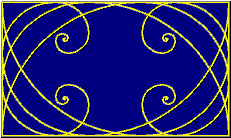

0, 1, 1, 2, 3, 5, 8, 13, 21, 34, 55, 89, 144, ... to infinity-->
This is called a 'Fibonacci series'.
If you then take the ratio of any two sequential numbers
in this series, you'll find that it falls into an increasingly narrow range:
1/0 = Whoa! That one doesn't count.
1/1 = 1
2/1 = 2
3/2 = 1.5
5/3 = 1.6666...
8/5 = 1.6
13/8 = 1.625
21/13 = 1.61538...
34/21 = 1.61904...
and so on, with each addition coming ever closer to multiplying
by some as-yet-undetermined number.
The number that this ratio is oscillating around is phi (1.6180339887499...). It's interesting to note that the ratio 21/13 differs from phi by less than .003, and 34/21 by only about .001 (less than 1/10 of one percent!), thus providing our less technically-advanced ancestors an easy way to derive phi on a large scale in the real world with a high degree of precision.
When you swing the long side of a Golden Rectangle around to create a new rectangle, the line it forms with the short side is made up of two sections having lengths of phi and one, respectively. This division of a straight line into a phi proportion is what is actually meant by the term 'Golden Section'.
[The Golden Mean] [The_Graphical_Derivation_of_Phi] [Derive_Phi_Exactly] [Unfold_the_Golden_Rectangle]